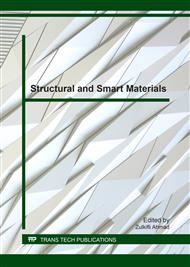[1]
Whittingham M S. Lithium batteries and cathode materi-als[J]. Chem Rev, 2004, 104 (10): 4 271-4 301.
Google Scholar
[2]
Dai J, Becquer T, Rouiller JH, et al. Influence of heavy metals on C and N mineralisation and microbial biomass in Zn-, Pb-, Cu-, and Cd-contaminated soils. Applied Soil Ecology. (2004).
DOI: 10.1016/j.apsoil.2003.09.003
Google Scholar
[3]
The output of lead storage battery in China accounts for 1/3 in the world [J]. China Nonferrous Metals Monthly. 2008(02).
Google Scholar
[4]
Bai Wenping. Market and recycling of NiMH battery[J]. China Rare Earth Information. 2014(12).
Google Scholar
[5]
Tian Xi-qiang, Zhao Dong-jiang,Bai Xiao-bo, et a1. Study on recovery Mn from wasted Zn—Mn battery [J]. Applied Chemical Industry, 2006, 35(9): 730-731, 735. (in Chinese).
Google Scholar
[5]
Aoshima T, Okahara K, Kiyohara, et al. Mechanisms of manganese spinels dissolution and capacity fade at high temperature[J]. J Power Sources, 2001 , 97 /98: 377-380.
DOI: 10.1016/s0378-7753(01)00551-1
Google Scholar
[6]
Yi J H, Kim J H, Koo H Y, et al. Nanosized Li Mn2O4 powders prepared by flame spray pyrolysis from aqueous solution[J]. Journal of Power Sources, 2011, 196: 2 858-2 862.
DOI: 10.1016/j.jpowsour.2010.11.038
Google Scholar
[7]
Wenping. Market and recycling of NiMH battery[J]. China Rare Earth Information. 2014(12) Song M, Ahn D S, Park H R. Capacity fading of spinel phase Li-Mn-O with cycling [J]. Journal of Power Sources, 1999 , 83 : 57- 60.
DOI: 10.1016/s0378-7753(99)00256-6
Google Scholar
[8]
Shen Yi-yong, Mi Yong-hong, Liu Chun-yan.Recovering zinc from waste alkaline dry battery with acid leaching process[J].Environmental Science & Technology,2006,29(12):68-69,72. (in Chinese).
Google Scholar
[9]
X. Zhang, Y. Xie, X. Lin, H. Li, and H. Cao, An overview on the processes and technologies for recycling cathode active materials from spent lithium-ion batteries, J. Mater. Cycles Waste Manage, vol. 15, pp.420-430, May (2013).
DOI: 10.1007/s10163-013-0140-y
Google Scholar
[10]
M. A. H. Shuva and A. S. W. Kurny, Hydrometallurgical recovery of valuemetals from spent lithium ion batteries, Am. J. Mater. Eng. Technol, vol. 1, p.8–12, February (2013).
Google Scholar
[11]
C. S. Dai, The recycling technology and suggestion of spent lithium-ion batteries, Beijing: The second lead battery & lithium-ion battery and secondary battery recycling technology seminar, pp.106-136, March (2013).
DOI: 10.1007/978-3-030-31834-5_1
Google Scholar
[12]
Zhang X F, Zheng H H, Battaglia V, et al. Electro-chemical performance of spinel Li Mn2O4cathode materi-als made by flame-assisted spray technology [J]. Journalof Power Sources, 2011, 196 : 3 640 -3 645.
DOI: 10.1016/j.jpowsour.2010.07.008
Google Scholar


